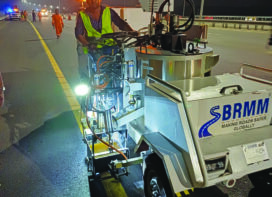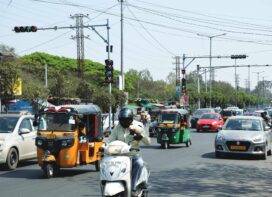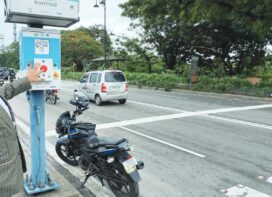Smart Traffic Surveillance project in Indore
The Tier II and Tier III cities like Indore is also in the forefront to implement Smart Traffic Surveillance project.
Indore police has developed an application called ‘Citizen Corp’ for the android-based mobile phone users. The app provides necessary platform for citizens to connect with the police. For example, there is a feature ‘report an incident’ in the app in which user/ citizen can upload photos as well as videos and send it to the police. This facility is available for citizens roundthe- clock. Complaints are categorized into Traffic, Domestic Violence, Harassment, Corruption and others.
For further action, the complaints are sent to concerned departments. Complainant sending maximum, genuine and useful complaints are awarded every month for helping the police in solving the problem. The application is in use from 2013 onwards. The response is good especially for traffic related violations like triple-seat riding, talking on the mobile while driving, designer number plates, vehicles parked at the No-Parking area etc..
Anjana Tiwari, ASP (Traffic) Indore, explained, “There are two types of information that we receive through this app; 1) actionable and 2) Nonactionable. We take necessary actions under actionable offence; we get suggestions as well information. Necessary actions are taken against violators who flout rules with proper evidence/proof like a clear image where the number place is visible. We have integration with Madhya Pradesh Transport Department’s website from where we obtain the data, and then challan is sent to violator’s address.”
Besides, the ‘citizen cop’ app also has another feature called ‘Tow Vehicle Status’. Vehicles that are towed away from the ‘No Parking’ zone are brought to the police station, the vehicle is given back to the owner only when he pays the fine. However, the problem arises when the vehicle owner is unsure whether the vehicle is been towed away or is stolen from the site. And thus, a ‘Tow Vehicle Status’ feature was developed in the app. Before the vehicle is towed away, the traffic police staff equipped with their android phones take the picture of the site where the vehicle was parked. So a user can check the status of his vehicle in the ‘Vehicle Search’ feature in the app.
In a way, this app helps traffic police to curb corruption and monitor day-today reports. The ‘Help Me’ feature for women security enables one to save four numbers from one’s contact list and by default the fifth number is saved as the Police Control Room. In case of emergency, within a short span of time the police from the nearby police station arrives at the spot.
To control the traffic, Indore police have selected 15 major junctions in the city. Out of the 15 junctions, the two junctions are fully functional from January this year. The remaining 13 junctions will be handed over to the Indore police by May. Issuing of challan has also been started at these junctions. So far, the traffic police have earned `17lakhs as revenue. With the help of this system, the traffic police is able to identify repeat offenders too. The `8.50Cr government funded
project was an open tender procurement project, which was won by the Delhi based company Technosystems.
Under the RLVD systems, Indore has installed the ANPR cameras. These cameras also called as ‘evidence camera’ read signals. So when the signal turns red, it makes a virtual line called ‘stop line’. When a vehicle crosses the stop line in the red-light signal, it immediately captures the image of the ‘Red-Light Violation’ event. It captures the vehicle and signal location. The software is developed in such a way that it integrates with the Motor Vehicle Department’s website. Subsequently, challan is prepared from the collected data.
ANPR cameras function for 24 hours, and thus they are able to maintain the database of all the vehicles passing by in this route. The cameras not only capture the images of the number plate but also read them. If there are any inaccuracy while reading the number plate, the vehicles passing through the ‘field of view’ can capture number plate of all the vehicles. As a result, the images come out very clear, and generate report based on the data the traffic police requires.
Tiwari, further added, “Indore is still far behind when it comes to traffic education, but with the implementation of the system, we have seen changes in the behavior of the people. We have not got a single accident report after implementation of the system. The system is quite transparent because the challan is produced on the basis of evidence. We can see visible discipline.”
The traffic police is already maintaining a ‘Traffic Management Centre’ with six 42-inch screens. The center receives regular feed from different cameras installed in various parts of the city. Besides RLVD, every junction has PTZ cameras for overall monitoring. In Indore, the two projects – City Surveillance Systems and RLVD – are part of ITMS project. Under city surveillance, dome-cameras are installed at 75 junctions.
Tiwari, explained, “Till date, there were no project on RLVD in India that has been implemented in such a large scale. We were apprehensive when we approached center for funds because we did not have any idea about the project or about total expenditure. We had no idea how many cameras we would require; we approached cities like Thiruvananthapuram and Jaipur to know more about the project. However, neither of the cities had complete estimates or proper plan where the project has been completely implemented. We did our research and charted out estimated number of cameras, the number of junctions where these will be installed, and how the system will work! Accordingly we submitted a tentative budget. The estimate of per junction came to `52lakh.”
“We can see a drop in 80% in the red-light violation. We have speed– radar for over speeding in different junctions and at BRTS project areas. We are procuring hand held device for issuing challan. With hand –written challan, there are a lot of issues like misuse of the violation. We have come across challans that have been manipulated by the violators. So, to evade this problems, we are going for on-the-spot challan with the help of a device. With this, we can have pictures of the vehicle and previous records of offences too. Around 48 more devices are expected. Having said that, whichever new technology is introduced in Indore, it is integrated; for example, the hand-held challan device will be integrated with RLVD system. So when a violator is caught, if there is a pending fine, the device will automatically alert or pop up in the screen.”
Every system has its limitations. Tiwari cites an example, “At times when the RTO website is not updated, it becomes difficult to tackle such issues. There are instances where the vehicle is registered for a two-wheeler and the driver is found driving a four or multi-axle vehicle. In such cases, the challan is filed in ‘hot-listed’ category and also updated on our website. We alert the RTO and the matter is sent to crime branch for further investigation. Looking at the success of our RLVD project, the Police Training Research Institute (Bhopal) will be introducing the system in cities like Gwalior, Bhopal, Jabalpur and Ujjain through common tender.
 TrafficInfraTech Magazine Linking People Places & Progress
TrafficInfraTech Magazine Linking People Places & Progress



